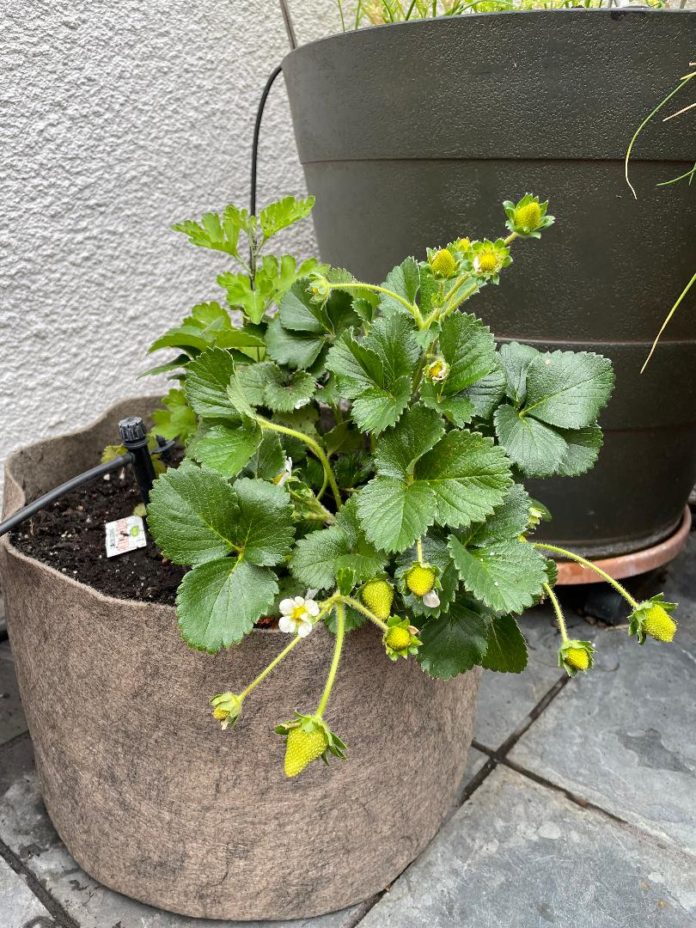Raised Bed Gardening Options and Tips for Success
In April, Eric Olsen spoke to the Mission Hills Garden Club. Olsen, like Bill Toone, is with High Caliper Growing, based out of Oklahoma City. Olsen has had seven years’ experience dealing with soils, plant sizes, plus how to raise plants in an organic and environmentally friendly pot which lends itself to raised bed gardening, He told us about a most unusual type of container, the Smart Pot®.
Olsen began with a brief history of agriculture. For most of time, people planted directly in rows, directly into the soil. With the invention of plows, they could mound soil for improved drainage and more surface area, providing more oxygen to plants’ roots, improving both quality and quantity of the product. The Egyptians found that by planting rows along the Nile, their crops received fertilizer from the minerals deposited by the river when it flooded. In the Middle Ages, crop rotation came into use. The Industrial Revolution brought the “dawn of chemical fertilizers.” Today, according to Olsen, these fertilizers are used on huge plots of land with both ideal and non-ideal soil using machines and farm labor,
He went on to discuss options for home garden planting. One option is to plant directly into the soil. This makes use of what is already present: existing soil and space. However, often the soil is not suitable for producing fruits, vegetables, or flowers. Drainage is often a problem; if the soil drains too quickly, there may not be sufficient time for roots to absorb nutrients from the water; slow drainage may cause the roots to suffocate and rot. Some soil is so bad one needs a tractor or an extremely strong back to prepare and aerate the soil.
Another option is a raised bed. By constructing a solid structure, you can fill it with soil you choose from the nursery or a site that has such for you to buy or take. Raised beds typically drain better than beds planted directly in the ground. Raised beds should save your back, allowing you to place a chair beside the bed and work comfortably. These beds may last as long as five years. The downside is that cost can be prohibitive and/or labor intensive. Unless you live in a home with a beds are difficult, if not impossible, to move. CCR’s may prohibit your doing this. If your containers are not large enough, plants become rootbound. Of course, wood containers will not last forever; most metal eventually deteriorate as well.
Plastic pots may be used for container gardening. They are inexpensive, weigh very little, and are easy to move. However, the plants may become rootbound more easily, circling and strangling each other. Drainage can be a problem. Standing water in saucers is a great breeding place for mosquitoes. Water on a deck or rooftop garden may eventually leak through the waterproofing, doing major damage to a home. Other insects such as “Leeches BPA (an estrogen mimicking substance)”, and black pots absorb heat (as high as 120 degrees), which can cause roots to stress and become damaged or dead. Extreme changes in temperature and ultra-violet rays cause plastic to crack.
Another option are clay pots. Many are beautiful and may be long-lasting unless they are dropped or hit by a falling object. Again, you may be creating a crowded root situation; the same drainage issues as plastic pots have. Additionally, they can be heavy and cumbersome to move. Cold and heat may also cause cracking or breakage.
For Olsen, the ideal solution to container gardening is the Smart Pot®, a patented aeration container. A company called High Caliper Growing has been in business for thirty years. It provided an alternative to dig up trees or having trees grown in plastic containers. The trees raised in the root control bag fared far better than trees grown in traditional methods, Eric told us. He went on to show us how, like the tree farmer, the Smart Pot® was good for the home gardener.
The Smart Pot® is a “fabric aeration container, made from a geotextile. 100 per cent BPA free,” with ultra-violet protection and, depending on its location, will last for three to five years. Some of its benefits include allowing air to circulate through the fabric, preventing circling roots, and allowing beneficial bacteria to thrive. In addition, this fabric pot releases heat. Studies have shown a 30-degree difference between the temperature of a plastic pot and a Smart Pot®. This means that in the hotter months, the plant can grow more. Furthermore, the drainage is superior. There is a greatly reduced chance of overwatering; the water drains completely. Since it moves by capillary motion, saturation is more even.
Olsen explained the results of using the Smart Pot® are “a more fibrous, dense root mass with more feeder roots, an overall healthier environment for your plant,” and “a healthier, more productive plant.” With no drain holes, debris doesn’t overflow to a reservoir, and the fabric pot gives you a wider choice of planting material. Not only does this pot release heat, but it can also be purchased from small sizes up to 1,000-gallon containers.
Outdoors, the plant has ground contact which helps plants’ roots and moderates moisture and temperatures in the Smart Pot®. They actually come with handles on sizes from three to twenty gallons and the fifteen and twenty-gallon pots have long-lasting strap handles. The pots come in a variety of colors.
The company has a host of other interesting products from watering solutions to transplanting gadgets, small items to enormous. Do go on the website to see more of the fascinating items they produce.
The next Mission Hills Garden Club meeting will be in September. Until then, stay safe, stay healthy, and relish life!

Category: Donations, Education, Gardening, Life Style, Local News, Nonprofit







